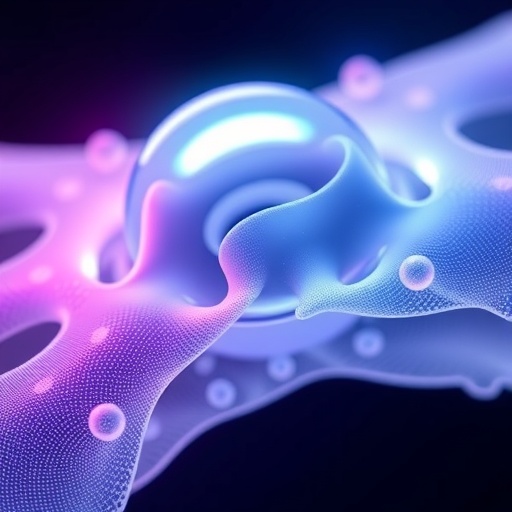In the rapidly evolving world of soft materials, a groundbreaking innovation has emerged from the realm of hydrogels, promising greater precision in the manipulation of pore structures. A team of researchers led by Professor Hyunsik Yoon at the Seoul National University of Science and Technology has developed an innovative facet-driven folding strategy. This method significantly enhances the control over how hydrogel pores behave in response to environmental stimuli, departing from traditional circular designs that often led to unpredictability in pore dynamics.
Hydrogels, renowned for their remarkable ability to swell and shrink based on changes in their environment, have found applications across various fields, from flexible electronics to targeted drug delivery. One particularly compelling challenge in the design of hydrogel-based devices lies in effectively managing the opening and closing of pores to trap or release substances, such as drug particles. Typically, hydrogels that employ circular pores are hampered by inconsistent actuation behaviors and slow response times, which can jeopardize their efficiency and effectiveness in critical applications.
The team’s approach introduces polygonal pores, integrated with origami-inspired hinge and facet architectures, to enable a more responsive and reliable actuation mechanism. Professor Yoon states, “Our design allows for a facet-driven folding strategy where the alignment of the hinges at the vertices dictates how the facets will move during the pore’s swelling and shrinking processes.” This control over the actuation process marks a significant leap forward, allowing researchers to predict and program the behavior of the hydrogel pores with greater accuracy.
Applications of this technology extend into the medical field, where the system demonstrates pH-triggered release of microparticles. The researchers note that by finely tuning the environment’s pH levels, they can orchestrate a staged release of microparticles from the hydrogel pores. This capability is particularly advantageous for drug delivery systems, where targeting specific areas of the body marked by variable pH can minimize systemic effects and enhance therapeutic efficacy.
The degree to which these polymeric materials can maintain their structural integrity is also impressive. Notably, the polygonal pores are reported to retain a remarkable 90% of their original shape even after repeated cycles of swelling and shrinking. This property not only underscores the reliability of the innovative design but also opens the door for various potential applications where durability is a key requirement.
Additionally, the researchers have ventured into the domain of information encryption using these hydrogels. They created a unique mixed matrix consisting of both square and circular hydrogel pores, filled with fluorescent particles. This setup capitalizes on the distinct closing behaviors of the different pore shapes, which allows for hiding and revealing patterns—an exciting frontier in the field of secure information storage and communication.
The implications of this facet-driven folding strategy are vast and varied. It not only presents improvements for current hydrogel technologies but also lays the foundation for future breakthroughs in numerous areas, including lab-on-a-chip systems and next-generation soft robotics. Such advancements could revolutionize how we think about drug delivery, environmental monitoring, and even smart textiles.
As researchers continue to explore the full potential of these innovative hydrogel structures, it becomes increasingly clear that they could usher in a new era of smart materials. These materials could seamlessly integrate into both everyday applications and sophisticated technological solutions, enhancing functionality while reducing risks associated with conventional systems.
In summary, the work carried out by Professor Yoon and his team exemplifies the intersection of creativity and scientific inquiry, showcasing how concepts from fields such as origami can be harnessed to solve complex engineering challenges. This research not only significantly enhances the precision of hydrogel actuation but also expands the horizons of what is possible with soft materials in various technological and medical applications.
As these scientists prepare to share their findings with the broader scientific community, the anticipation surrounding their work grows, with the hope that more researchers will adopt this innovative strategy to further enhance the capabilities and applications of hydrogels in the future. The trajectory suggested by their initial results indicates a bright future for facet-driven hydrogel technologies, potentially changing the landscape of soft materials science for the better.
The insights gained from this research may lead to refined methodologies and protocols for developing highly tunable hydrogel systems that can be applied in diverse industries, from healthcare to environmental remediation. Overall, the implications of this innovative approach signal a significant milestone in the development of next-generation materials, and the scientific community is eager to witness its impact.
Subject of Research: Reversible actuation of hydrogel pores
Article Title: Facet-driven folding for precise control of hydrogel pore actuation
News Publication Date: 30-Jun-2025
Web References: DOI link
References: Journal Matter
Image Credits: Seoul National University of Science and Technology (SEOULTECH)
Keywords
Hydrogels, polymer engineering, drug delivery, origami-inspired structures, soft materials, pH-responsive systems, information encryption, advanced manufacturing, biomedical applications, smart materials.




